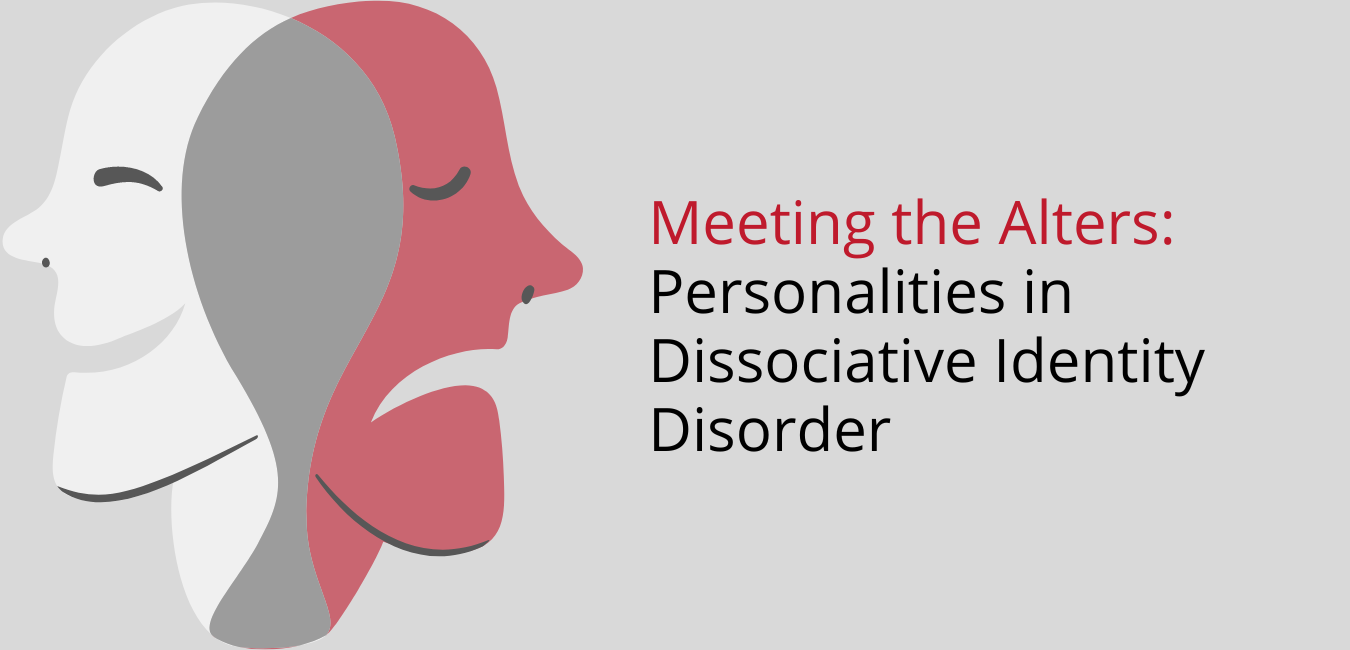
Dissociative Identity Disorder, formerly known as Multiple Personality Disorder, is characterized by disruption of identity, with two or more distinct personality states, each having their own perception, sensory and environmental experiences. Marked discontinuities in self and agency are noted. The personality states recurrently take charge of executive functions, and each of them may be accompanied by a change in affect, cognition, sensation, perception, and even motor control.
Alters
The alternate personalities in DID are often referred to as ‘Alters.’ Alters typically develop from dissociation caused by prolonged early childhood trauma, as evidence suggests (International Society for the Study of Trauma and Dissociation, 2011). The alters may have different names, genders, ages, roles, attitudes, preferences, and even memories. They may also consider themselves to be having different medical conditions like allergies or diabetes etc. Interestingly, different alters have also shown different results in neuroimaging tests, including fMRIs, brain activation, regional blood flow, and differences in PET scans.
All alters can be broadly classified into Apparently Normal Parts of the personality(ANPs) and Emotional Parts of the personality (EPs). The ANP is usually like the host personality, who manages daily life and does not have trauma memories. There may be more than one ANP, each having its own role. The EPs mostly hold the traumatic memories, along with the sensory experience of the traumatic event. They may also be unaware of the passage of time.
Often, alters are considered ‘Ego states’ while they are not as ego states can exist in individuals without alters and do not involve dissociative symptoms, amnesia, or clinical distress. Some commonly observed alters are the Child alter (holding childhood memories, especially that of abuse), the Dead alter (memories of a near-death experience), or the Caretaker (care for other alters).
Development of Alters
As discussed before, excessive and prolonged childhood trauma may result in the child being overwhelmed and dissociating to form one or more separate identities to manage the traumatic stress. Often, in order to overcome the trauma, the individual evaluates themselves and the traumatic experiences from diverse perspectives. The perception of self coming from these diverse perspectives comes together around different focal points. Thoughts, emotions, and behavior begin to attach themselves to these focal points. These aggregate together to become alternate personalities following repeated visits and utilization. The host personality is then protected from all new and past traumatic experiences. They are now held with the ‘alter’ or multiple alters, becoming a means of coping (Ozturk & Sar, 2016).
Co-Consciousness?
One must also note that at times it is possible for two alters to have a partial memory of events and be aware of each other’s presence. Such a situation (Co-consciousness) usually involves two alters being aware of each other and having an ongoing memory of a situation or a time period. We normally observe one of them being in executive control, though it is not necessary for both of them to behave as one. For people with Dissociative Identity Disorder, facilitating co-consciousness can be an excellent medium for reducing amnesia and improving daily life coordination and function (Haddock, 2001)
Alters in Therapy
In psychotherapy for Dissociative Identity Disorder, alter personalities constitute the key elements. They determine the appropriate psychotherapeutic approach, rapport, focus of inquiry, and resistances in psychotherapy, all directly affecting the treatment algorithm. It is usually observed that the total number of alter personalities may not reflect the severity of the problem as much as the number of times an alter personality undergoes psychological processing.
Self is critical as the successful integration of alter personalities depends on how the individuals themselves take responsibility for the mission. It is helpful for the therapist to know why a particular personality exists and when it usually shows up to determine the disorder’s severity and curate an effective treatment plan. The therapist must also be aware that flashbacks, hallucinations, and trauma-related psychosis may be experienced during the therapeutic intervention and be prepared for the same.
It can often be challenging for a therapist to deal with Dissociative Identity Disorder as the rapport, goals, and intervention technique needs to address the needs of the varied personalities. Resistances due to the different alters are quite frequent. However, the goal should be consistent- integration of the identities and effective daily functioning. People with dissociative identity disorders can live long and fulfilling lives, it is time we beat that stigma!
Author,
Aseess Chadha,
Clinical and Research Intern, PsychLine.in
References
DIDisreal (2016, April 16). Alter identities in dissociative identity disorder (MPD) and DDNOS. Trauma dissociation. Retrieved September 12, 2022, from http://traumadissociation.com/alters
Haddock D, (2001). The Dissociative Identity Disorder Sourcebook. McGraw-Hill, ISBN 0737303948. Read more: http://traumadissociation.com/alters
International Society for the Study of Trauma and Dissociation. (2011). Guidelines for treating dissociative identity disorder in adults, third revision. Journal of Trauma & Dissociation, 12(2), 115–187. https://doi.org/10.1080/15299732.2011.537247
Sar, V. (2016). Formation and functions of Alter Personalities in dissociative identity disorder: A theoretical and clinical elaboration. Journal of Psychology & Clinical Psychiatry, 6(6). https://doi.org/10.15406/jpcpy.2016.06.00385
World Health Organization. (2019). International statistical classification of diseases and related health problems (11th ed.). https://icd.who.int/